
Welcome back to Part 4 of the Galactus Design Diary with your hosts Andrew Yip and Billy Zonos. As always, this week’s article will be simulcast en Espanol and close captioned for the hearing impaired. *Cough* Yip *cough.*
Let the Record Show that Everything I’m About to Say is the Truth
One Year Ago:
Andrew: Yeah, Mike doesn’t think that doing the Kree over the Skrulls is such a hot idea.
Billy: Did something happen to his head? Concussion? Severe hemorrhaging?
A: Hey, I agree with you cuz you’re awesome. Maybe you should write him an e-mail explaining our position?
B: Great idea. When we first met, I thought to myself, “This guy is awesome.” Now, I find you’re both awesome and mildly intelligent. Good times.
A: You thought I was awesome?
From: Billy Zonos
To: Hummel, Mike
Subject: What the Kree!?!?
Why the Kree are more relevant than the Skrulls
By
Billy Zonos
1) The last time the Skrulls did anything significant was way back in the Kree/Skrull War.
2) The Skrulls are just fruity-looking aliens who can change shape.
The End
Unique Skrull Characters:
- Super Skrull
- Paibok
- . . .
Unique Kree Characters:
- Admiral Galen Kor, Lunatic Legion
- Blue Kree Soldier, Army
- Bron Char, Lunatic Legion
- Captain Att-Lass
- Captain Mar-Vell, Soldier of the Kree Empire
- Clumsy Foulup, Puppet Dictator
- Colonel Yon-Rogg
- Commander Dylon Cir, Lunatic Legion
- Dr. Minerva
- Korath the Pursuer (Starforce)
- Lieutenant Kona Lor, Lunatic Legion
- Lunatic Legionnaires, Army
- Medic Una
- Nenora, Skrull in Disguise
- Pink Kree Soldier, Army
- Ronan the Accuser
- Ruul Soldier, Army (Feral)
- Sentry #459
- Shatterax (Starforce)
- Sintariis, High Kronamaster of the Ruul
- Supreme Intelligence
- Supremor (Starforce)
- Talla Ron, Lunatic Legion
- The Accusers, Army
- Ultimus, Kree Eternal (Starforce)
It’s so obvious! Live Kree or Die, baby!
-Billy
From: Hummel, Mike
To: Billy Zonos
Subject: RE: What the Kree!?!?
[This e-mail is long and boring, so let me sum up with some notable quotes.]
“. . . I’m not in disagreement that the Kree are a better fit in terms of theme . . .”
“. . . people have been joking about Skrull decks from the very beginning and . . .”
“. . . I think we can minimize Skrull content . . .”
“. . . I’m really excited . . . about . . . working with . . . such a clever . . . character . . . (Billy Zonos) . . .”
“I think we could potentially get clever with the mechanic of dual affiliation and the theme of Skrull shape-changing to get enough content to allow people to build casual Skrull decks . . .”
-Mike
From: Billy Zonos
To: Hummel, Mike
Subject: What the Kree!?!?
Thanks for your quick reply. You’re awesome.
-Billy
From: Hummel, Mike
To: Billy Zonos
Subject: RE: What the Kree!?!?
You really think I’m awesome?
-Mike
I lied (obviously not about Mike being awesome). It was me the whole time who was the architect of their exclusion. The Skrulls were out! The Kree were in! It was a hollow victory because those darn Skrulls made their way back into the set in a big way. That really was Yip’s fault.
Pressing it to the Limit
The Kree are one the oldest races in the Marvel universe. They are also one of the three most powerful races in that universe, the others being the Shi’ar and the Skrulls. Their militaristic empire is ruled by the Supreme Intelligence—a gelatinous, disembodied, synthetic being composed of the greatest minds in Kree history. The Kree, as a rule, love interstellar conflicts. Their war with the Skrulls spanned thousands of years. These guys know how to hold a grudge and they’ve got the technology and training to back it up.
So, who and what make up the Kree’s militaristic mythology? Who are the major players? What are their major storylines? A cursory glance at Wikipedia gave us the Kree/Skrull War (Avengers Vol. 1 #93-97), Operation: Galactic Storm (Avengers: Galactic Storm TPB 1 and 2), “Live Kree or Die” (1998 crossover in the main Avenger books), and “Maximum Security” (Maximum Security #1-3).
Unfortunately, the Kree/Skrull War features the Skrulls almost as much as the Kree, so that’s out. That’s okay, though—Operation: Galactic Storm is so massive that it could literally be its own set. In fact, I almost wrote another e-mail about the Shi’ar. Using Operation: Galactic Storm as the basis, we filled in the rest of the roster of characters and non-characters with references to “Live Kree or Die” and “Maximum Security”. We made sure to keep the “Maximum Security” storyline’s influence to a minimum because it wasn’t one of the more fondly remembered crossovers. In the fans’ eyes, I think it ranks just below the Clone Saga. But it did give me an excuse to wedge Ego the Living Planet into Heralds of Galactus.
With the storylines decided, we had two main sub-teams: The Lunatic Legion and Starforce. The Lunatic Legion was a rag-tag group of Kree terrorists working clandestinely for the Supreme Intelligence. Starforce was the Kree’s answer to the Shi’ar Imperial Guard during Operation: Galactic Storm. Since both of these sub-teams have a decent number of members, I wanted to be sure that they were presented in unique ways when I wrote up the art descriptions.
Since the Lunatic Legion almost always fought as a cohesive unit, I wrote them that way in the art. To show the tremendous power of individual members of Starforce, I portrayed them in one-on-one combat with various Avengers from Operation: Galactic Storm (with the notable exceptions of Dr. Minerva, who thematically would not be fighting, and [Ronan]). As always, what we write is open to artistic interpretation.
The Kree are a militaristic society (which is the thematic origin of the press mechanic, as I’m sure Andrew will get into), right? So, where are the army characters? Good point. Let’s round them out with army types like Colonel Yon-Rogg; Mar-Vell ◊ Captain Marvel, Soldier of the Empire; Kree Public Accusers; Kree Commandos; and Kree Soldiers. And, of course, we have our loose ends like Nenora (SKRULLS!) and Clumsy Foulup. Oh yeah, and the Ruul. We didn’t forget them . . . although it seems as though Marvel has.
(Before we go any further, I just want to point out one of the only influences I had on actual card design: the return of 5-cost Army characters in MHG. Bust out those Master Molds!)
With a decent character list set, we moved on to telling their “story” through plot twists, locations, and equipment. These cards fell into the following categories:
- Operation: Galactic Storm: Nega-Bomb, Remnant Fleet, Starforce Strike, The Infamous Seven
- “Live Kree or Die”: Live Kree . . . or Die!, Penal Colony, The Lunatic Legion
- “Maximum Security”: Genetic Destiny, Planet Weapon
- Making Fun of Skrulls: Conquered Planet, Strategic Retreat
Wait, you say that Strategic Retreat has Shi’ar soldiers on it and not Skrulls? Well . . . yeah! Why would the Kree be running away from the Skrulls?
Notable loose ends include Enemy of the Empire and Stargate. Enemy of the Empire is in there to explain the different versions of Captain Mar-vell in the set. Stargate was originally conceived as a generic location because the stargates in the Marvel universe aren’t really owned by any one alien race. They’re like a freeway system with maintenance paid for by everyone. Hmm . . . imagine if Stargate were generic. How sweet would that be?
Militarism in Art
This week, I want to showcase the pieces that we used to push the militaristic theme of the Kree with some of the press enablers.
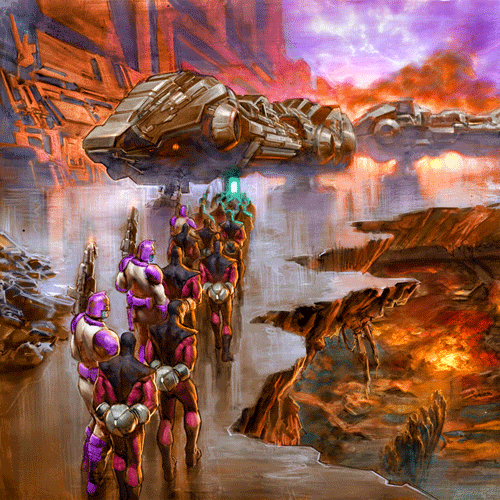
Conquered Planet –
Setting: A Skrull Planet
Action: Wide Shot: Captured Skrulls are being led into Kree landing ships, which are sitting in the background. The Skrulls look beaten, their heads low and shoulders slumped. A squad of Kree soldiers gathers in the foreground. There are signs of an epic battle all around—fire and smoke in the distance.
Focus: The Devastation
Keywords: Invasion, Enslavement
Heh. Skrulls.
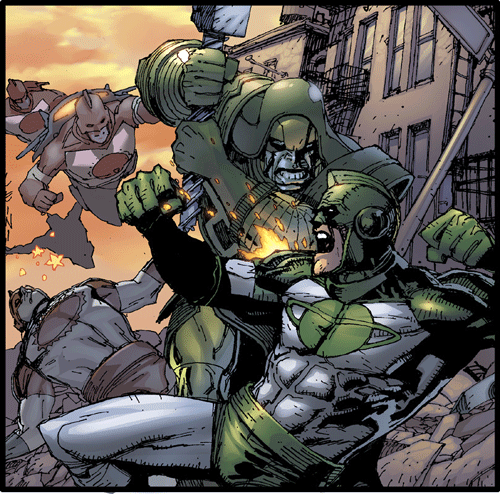
Enemy of the Empire
Setting: New York, Earth
Action: Captain Mar-Vell and Ronan are fighting on the streets of New York. Mar-Vell has been branded an enemy of the state and is facing Ronan’s final judgment. Their battle is fierce; both men are pummeling each other intensely. In the background, Kree soldiers with jetpacks swoop down to assist Ronan.
Focus: Ronan & Captain Mar-Vell
Keywords: Search and Destroy
Oh Mar-Vell, you can’t quit Ronan that easily.
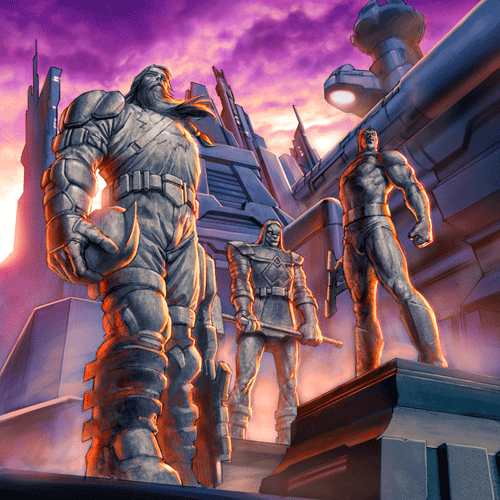
Hala
Setting: Hala
Action: Aerial Shot: We are looking down on a technologically beautiful Kree city on Hala. It is a militaristic society; we should be able to see numerous large statues depicting famous war heroes. The architecture should be Kirby-inspired.
Focus: The Large Statues
Keywords: Technological Sophistication
References: Operation: Galactic Storm
This was a really difficult piece to find a reference for. A couple of the middle issues of Operation: Galactic Storm had some panel art that sort of matched the ideas we were going for, but not quite. Since it was background art, it wasn’t overly detailed. In the end, we let the themes of the team inspire the look of their home world.
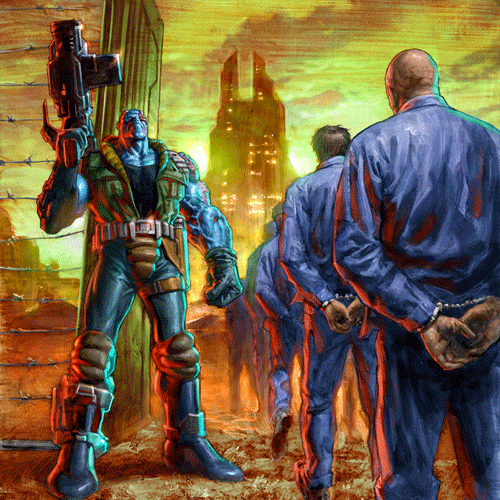
Penal Colony
Setting: Prison Camp, Earth
Action: Wide Shot: In the foreground, we have a really mean looking Lunatic Legionnaire, fully armed and standing at the gates of a prison camp. Marching past him are human prisoners (in prison uniforms) headed into the prison. In the background, we have a couple of small huts (sleeping quarters) and a large, ominous looking building (a building where the humans will be exposed to the Terrigen Mists in order to mutate them). This piece should evoke some dark feelings, but let’s try not to be too obvious. The original storyline used a Nazi concentration camp theme, so we could tone it down a little here.
Focus: The Dark Nature of the Camp
Keywords: Innocent Americans, Prisoners of War
References: Captain America Vol. 3 #7
This was a weird one. Although I’m extremely happy with the way it turned out, I was very tentative about including any overtly suggestive themes. The artist did a great job of capturing the essence of what we wanted while still hiding the political references. Mauro Cascioli was at least as subtle as Andy Kubert, the original artist on Captain America.
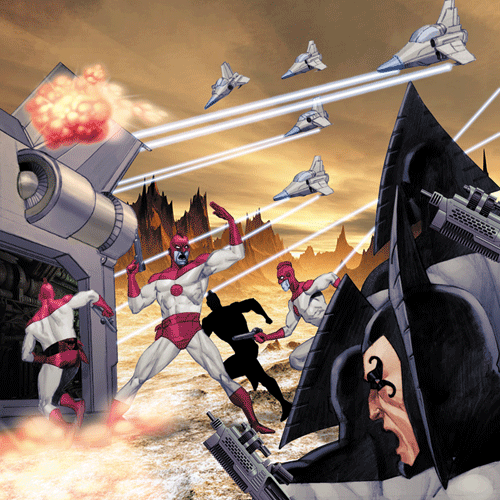
Strategic Retreat
Setting: Alien Planet
Action: Wide Shot: In the foreground, to the left, we have a blue Kree Captain ordering his men to retreat. In the center, blue and pink Kree soldiers are falling back. In the background are waiting transports with more Kree soldiers. On the right, the fringe of the shot, we have Shi’ar soldiers advancing on the transports. All the while, the Kree are taking tremendous fire.
Focus: The Kree Soldiers
Keywords: Retreat, Overrun
One of the many references to the Shi’ar. Hopefully, we’ll get around to featuring them in a future Vs. expansion.
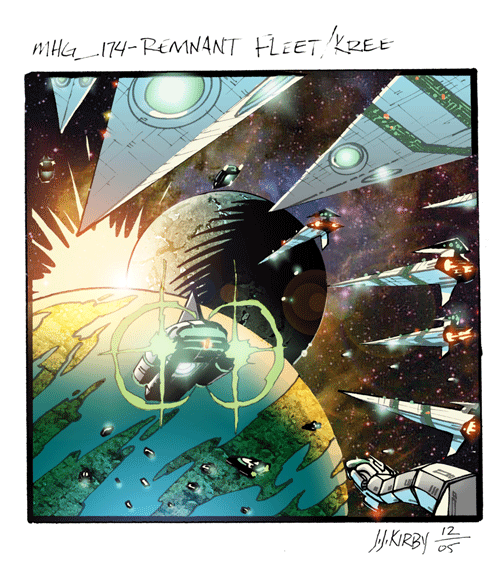
Remnant Fleet
Setting: High Orbit, Alien Planet
Action: Wide Shot: A small contingent of Kree space cruisers sits in orbit above a lush planet. Transports can be seen traveling between the fleet and the planet.
Focus: The Kree Starfleet
Keywords: Preparing for Battle
What does this card remind you of?
That’s enough self-indulgence for now. Enjoy the rest of the article (the best part of the article), and I’ll be back at the end as usual to give you useless bits of info.
Records for this Time Period are Spotty at Best
Anyone with an encyclopedic knowledge of Vs. cards (the list of which probably begins and ends with me) would immediately recognize the first incarnation of the press mechanic:
Press (This character costs 1 less to recruit for each Kree character you have recruited this turn)
If you missed the reference, press was inspired by a very innocent-looking equipment in the second Marvel Vs. set ever printed:
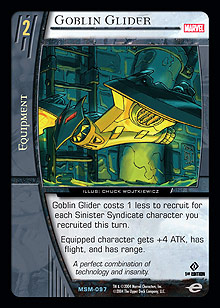
The glider, along with the Armored Spider Suit and Surrounded, represented one of R&D’s first efforts at promoting off-curve strategies. During Avengers design, R&D wanted to revisit the promotion of these strategies. The lethal fruit born from this initiative was the Faces of Evil archetype, which presented players with a large number of cards that rewarded and facilitated off-curve strategies. Cards like Hard Sound Construct; Melissa Gold ◊ Screaming Mimi; and Beetle, Armorsmith provided consistency and powerful effects to off-curve strategies. One of the ideas that didn’t see the light of day at the time, though, was the return of the glider mechanic. Several of the initial designs for the Thunderbolts team included plot twists that counted the number of characters you had recruited that turn, including:
Justice like Lightning!
Plot Twist, Threshold 6
<cardname> costs 1 less to play for each Thunderbolts character you recruited this turn. <p> Target character gets +5 ATK this attack.
The set of high-threshold plot twists provided a similar handhold to the original glider and accentuated the team’s already prevalent “resource threshold” theme. Because of the abundance of themes already on the team, the high threshold cards were eventually cut from the Thunderbolts and the mechanic was scrapped until design began for Heralds of Galactus.
The Goblin Glides Again
As I said in my first design article, one of the main goals of Heralds of Galactus was not only to highlight Galactus himself, but also to differentiate the Heralds team from the other teams as much as possible. This meant that even though the set was intended to promote curve decks, an off-curve strategy was still thematically fitting. How better could we exhibit the sheer magnitude of Galactus than to have him destroying a field full of characters?
Considering that either the Kree or the Skrulls were going to be a main team in the set, a mechanic that represented the invasive, military nature of these aliens seemed appropriate. While the Heralds of Galactus team focused on big, central characters, the armies of the Kree would focus on having a lot of characters in play and caring more about the whole than the individual. This idea resurrected the glider mechanic, retrofitted to characters and plot twists. On characters, it represented the recruiting efforts of the army, while on plot twists, it represented the army’s united movements and goals. In addition to the thematic fit, press promoted consistency when a player would normally not be able to spend all of his or her resource points. With enough card drawing, it was possible for a press deck to spend its resource points successfully each turn without an abundance of time-consuming search effects. Press also presented players with a new decision point; since low cost characters could be recruited later at a reduced cost, it wasn’t always right just to recruit every character you could each turn. If a player was weary of his or her characters becoming stunned, he or she could save them in hand until later turns when they would be more relevant.
Developmentally, several issues immediately arose with the press mechanic. For one, since it was difficult to regulate how many characters a player could recruit in a turn, it was easy to construct decks that would accelerate a 6- or 7-drop press character into play for no cost on turn 4 or 5. This quickly prompted the first revision of press:
Press (This character costs 1 less to recruit for each press character you have recruited this turn, to a minimum of 1)
This fixed the problem insofar as it allowed the developers to regulate which characters could be recruited at an accelerated rate, and ensured that each character would cost at least 1 resource point. But it made the mechanic extremely insular, since you generally didn’t want to play non-press characters in the deck. Another revision was required so that a press deck could play non-press characters while still restricting the power level. After some consideration, the design team reversed the direction of the cost reduction, making the press characters affect the characters you recruited after them as opposed to counting the characters you’d already recruited:
Press (Characters you recruit this turn cost 1 less to recruit this turn, to a minimum of 1)
Several undesirable interactions and broken decks later, and the final press text was formed:
Press (When you recruit this character, your next character costs 1 less to recruit this turn for each press character you recruited this turn, to a minimum of 1)
Press was particularly fitting for the military-minded Kree. Thematically, press made sense on the high-ranking military officers and leaders of the people. The play experience also satisfied the theme of the team, as the Kree player could keep characters in hand until the final decisive strike.
Run Away!
As the press mechanic developed for the Kree, there were still a sizable number of cards to be designed for the team. To complement press and to highlight the idea of a Kree invasion, a retreat theme was added to the team. Coming off a set that used characters returning to hand to pay costs (Villains United), returning characters as an effect fit into the grand scheme of things and complemented the press mechanic. With the addition of the retreat cards, the Kree could now recruit characters and retreat them before they were KO’d so that they could fight another day. In this fashion, retreat cards provided the Kree with their own brand of recovery effects and preserved their card count. Incidentally, it also promoted the reuse of come-into-play powers, such as those found on characters like Lieutenant Kona Lor and Dr. Minerva.
No Resource is Safe
The final theme designed for the Kree was their resource-hate cards. The anti-resource theme was initially intended to be the Kree’s piece of the “resource row matters” pie. The Inhumans cared about their own face-up resources, the attack-minded Kree destroyed their opponents’ resources, and Galactus ate everything in sight. The anti-resource theme didn’t fit necessarily with the other themes of the team, but reservist also made the Kree the most resilient against their own powers. Ultimately, the resource-hate theme would be reduced for several reasons, including the desire to accommodate a future team to be designed and the fact that Galactus lost his own resource-eating powers.
The “Final Thought”
This is the part where I apologize and tell stories.
- The original Captain Att-Lass roughs came back depicting Wonder Man beating on Captain Att-Lass. How embarrassing to be beaten on your own card.
- Clumsy Foulup’s art was not supposed to be good. But I guess it served its purpose, since it fooled a lot of people into thinking it was a good card. Didn’t someone play a Power Gem on him at a recent $10K?
- Lieutenant Kona Lor is not supposed to be green. She is not a Skrull in disguise. I think this was a printer error. Riiiight.
- No, that is not Zordon from the Power Rangers. That is the Supreme Intelligence. Gosh!
- Why is there a poem linking Ronan the Accuser, Starforce; Hala; and three of the Kree Army characters in the set? I don’t know—it’s a mystery.
- How many times does Captain America appear on Kree art? Four. Not nearly enough, because I wrote him on three other cards that were cut. And, that’s not counting Assault and Battery (should this one count twice?) and Captain America, Skrull Imposter. What? I like Cap. Just wait ’til Marvel Team-Up!
Wow, I’m beat. Join us next week for the mother of all re-features, Doom! ’Til then, this is Y&Z telling you to take care of yourselves and each other.
Heralds of Galactus Wallpaper: Ronan the Accuser, Starforce